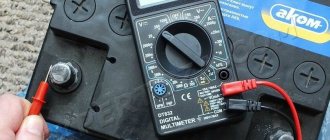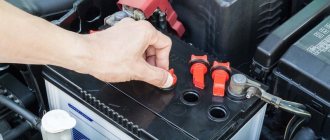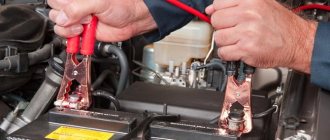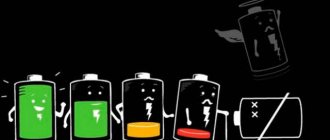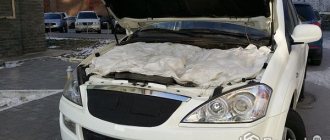As soon as it gets cold outside, most car owners encounter a problem when the battery is discharged, and therefore the car starter does not turn over. This phenomenon causes a number of inconveniences, because the vehicle may refuse to start at the most awkward moment. In order to avoid such a situation, it is necessary to prepare the battery for winter and the onset of cold weather.
The reason for this problem lies in the fact that in winter the battery starts the engine with thick oil, and accordingly the load placed on the battery increases sharply. Charging the battery begins from the moment it warms up, that is, while driving.
To prepare your battery for winter you need to go through 2 simple steps :
- Charging the battery using a charger and restoring the density of the electrolyte.
- Insulation of the battery using insulation and special devices.
At the end of the article you will find detailed video instructions that will clearly show how to apply all the knowledge gained from the article in practice.
Why does my battery drain faster in winter?
Before you understand how to prepare a vehicle battery for cold weather, you need to understand the reasons for the difficulties that arise. In winter, the battery operates in extreme mode due to the following factors:
- High energy consumption for heating the interior, windows and mirrors.
- Short trips that do not allow the battery to fully charge.
- Frequent starting of the starter , which occurs due to the difficulty of starting a cold engine.
The last reason is less significant, since this problem can be solved when the battery is fully charged and produces the required current in accordance with the required parameters. Experienced car enthusiasts also advise using a little trick - before starting the engine, you can turn on the headlights, leaving them on for a couple of minutes, which will allow the battery to warm up.
It is physically impossible to solve the second problem, since traveling short distances is a fact that must be put up with. To mitigate the importance of the first reason, you need to refrain from turning on additional equipment. If it’s cold in the car, then you need to wait a little, refusing to heat the interior, at least for the first 5-10 minutes from the moment you start driving.
Removing the battery from a car in cold weather
During the cold season, the battery charges much less well, which can affect engine starting. The solution to the problem depends on the life of the battery: new ones fail extremely rarely, so it will be enough to “warm up” the battery by turning on the headlights for a couple of minutes, after which you can start the engine. With old batteries, everything is much more complicated, because they need to be removed and moved to a warm place for charging and cleaning.
Even a beginner in this matter can remove the battery from a car, the main thing is to follow the instructions:
- Open the hood of the vehicle.
- Remove the “insulation” - this point is not for everyone, since it is not always present.
- Disconnect the "negative" terminal.
- Remove the positive terminal.
- Remove the battery mount.
- Remove the battery.
- Check the ventilation openings and their cleanliness; if there is dirt, it must be removed.
- Remove dirt from the battery case using a solution - 1-2 teaspoons of soda per glass of water. The importance of this procedure is difficult to overestimate, since dirt can cause self-discharge of the device.
When removing the terminals, you need to make sure the order is correct. If you initially disconnect the “positive” terminal, this may lead to a short circuit and damage to the entire electronics of the car. It is also necessary to remember that under no circumstances should the battery be tilted or knocked on it .
Is it possible to charge the battery at home?
Every car owner knows that the car battery is one of the most important parts of the “iron horse”; thanks to it, a kind of start-up of the ignition system is performed. Basically, in a car there is a continuous cycle between the alternator and the battery. The battery provides energy to start the engine ignition system; the internal combustion engine, in turn, rotates the generator armature, from which current is supplied to all electrical appliances of the car, as well as to charge the battery.
However, in some cases, problems arise with the battery, since a low-quality or old battery begins to fail the car owner over time, and a new one in a frosty winter can bring unexpected troubles. Therefore, the car owner should know some points regarding the battery charge, as well as certain features of its behavior at different ambient temperatures.
Often, motorists whose batteries require constant recharging charge the batteries at home, but only a few think about the fact that this can cause some harm to people living indoors. When charging, a chemical reaction occurs in the battery, releasing toxic substances such as sulfur dioxide, arsenic and hydrogen chloride.
These chem. the connections subsequently cover all surrounding objects and with constant practice of charging the battery at home, residents experience some kind of malaise, coughing, and sometimes nausea. But there is still a way out of this situation - recharging can be done on the balcony, but in this case it must be constantly ventilated throughout the entire procedure.
After purchasing a new battery, it is recommended to discharge it as much as possible and recharge it several times, repeating this procedure 2-3 times. This is believed to extend its service life. So, returning to the question of charging before winter, it should be noted that in general this is even very desirable, moreover, it would be good to discharge it thoroughly before that.
Modern chargers also have this function. In addition, before winter, it is recommended to visit a car service center and check the density of the electrolyte in the battery and, if necessary, increase it. In principle, this is not necessary to do before summer, but in the case when the battery is already reaching its end, it is quite advisable. In general, charging a battery is not difficult, but it is worth remembering that the charging current should not be significantly higher than the current of the battery itself.
By treating the car's power source with care, it will last for quite a few years, without any unpleasant surprises for its owner. But still, we shouldn’t forget that there are quite a lot of low-quality offers on the market now, which will allow you to save on your purchase at first, but will later cause a lot of trouble. It is much more cost-effective to purchase an expensive, but high-quality option, but then the choice is up to the driver.
Charging your battery while preparing for winter
The first and most important step in preparing a battery for the winter is charging it. First of all, you need to remove the battery from the vehicle, and then thoroughly clean it to remove all types of contaminants. The next step is to clean the terminals with sandpaper, which improves contact (current conductivity).
Before charging a car battery, it is necessary to unscrew the plugs from the filler holes (cans), which will give access to the electrolyte and check its level. Optimally, it should cover the plates by 1-1.5 centimeters. If this condition is not met, you need to take distilled water and add it to all holes.
The next step is charging the battery. To simplify this process as much as possible, it is advisable to purchase a popular charger (charger), which allows you to minimize the amount of work performed. During this you need to follow some rules:
- It is necessary that the plugs remain unscrewed (open filler necks).
- When connecting the charger to the battery, it is important to observe the polarity: the black wire is the negative terminal, the red wire is the positive terminal. An error in polarity can damage the charger, with the exception of devices that have special protection.
- Once you have connected the charger to the battery, you can plug it into the power supply.
- Expensive chargers prevent the electrolyte from boiling strongly during charging; however, it is recommended to carry out the battery charging procedure in a ventilated, and preferably non-residential, area (for example, a loggia or garage, or, in extreme cases, a corridor).
- Leave the battery to charge; this procedure takes from 10 to 13 hours.
- You can verify that charging is complete by checking the gas bubbles released from the electrolyte.
Once the battery is fully charged, it must be unplugged and left for a couple of hours to settle.
Minuses
It is worth understanding that there is a possibility of harm to the device. It is necessary to sort them out in order.
Improper charging will certainly damage the device.
Failure to observe the polarity of the charging unit connection will lead to failure. Therefore, you will need to figure out exactly what steps you need to take to prevent it.
Always observe the polarity of the charger connection. Connect the red wire to the positive pole, and the black wire to the negative pole. Most of the source failures are associated with incorrect connection before charging .
To do this, you should use the following tips:
- Always observe the polarity of the charger connection . Connect the red wire to the positive pole, and the black wire to the negative pole. Most of the source failures are associated with incorrect connection before charging.
- Only after completing the 1st step is the power connected . The order cannot be changed.
- The charging process may be accompanied by boiling of the electrolyte . Therefore, the room should be well ventilated.
- If the owner of the car has pets, then they will need to protect their access to the room with the battery.
- The duration of a full charge is 12-13 hours . Not more. It is very important.
Exceeding the charging time will shorten the service life
Its operating principle is based on the movement of electrical particles in a conductor. The conductor is water . When charging, the liquid begins to boil. At this moment, diffusion of molecules in space occurs. When the time is exceeded, water chemically decomposes into hydrogen and oxygen. There are fewer active particles, and the battery loses its properties.
High voltage is harmful to the battery
Besides time, tension is important. The advice in paragraph 5 is valid at rated voltage and current. If exceeded, the duration to full charge decreases. Most often this happens due to the converter not working properly.
That is, if the device is handled incorrectly, it can simply be damaged or its service life shortened. In any case, this negative factor can manifest itself at any time.
Choosing the moment of charging
Any battery has a parameter “number of charges and discharges” . This is the limit for the number of cycles after which the battery becomes unusable. It is recommended to always take this parameter into account. You will need to choose the moment to recharge wisely.
Complexity of technology
The technology itself is complex and requires due attention. Therefore, battery breakdowns often occur.
How to increase the electrolyte density in a battery in winter and summer
Now you can start checking the density of the electrolyte; a special device, a hydrometer, will help you take measurements. The electrolyte is an aqueous solution of sulfuric acid, so you need to be careful and carry out all procedures using special rubber gloves .
The density of the electrolyte is based on the ratio of distilled water and sulfuric acid - 1 to 1.25, respectively. Therefore, the normal density of the electrolyte is 1.25-1.27 g/cubic meter. cm at temperatures from +18 to +25 degrees Celsius, and in order for it not to freeze in winter, the density must be at least 1.18 g/cu. cm.
You can increase the density of the electrolyte by draining the old aqueous solution of sulfuric acid from the battery, replacing it with a new ready-made one, which can be found in any specialized store. You can also buy battery acid and distilled water yourself, mixing them in the correct proportion.
Important! Many inexperienced car enthusiasts advise increasing the density by adding a new, higher density electrolyte to the old electrolyte. If you mix two electrolytes of different densities, this will lead to the destruction of the lead plates, and the result is that in a few months you will need to buy a new battery.
As soon as the electrolyte density and the battery charge level have returned to normal, the final stage of preparing the battery for winter should be carried out - checking the voltage at the terminals. To do this, you can take a voltmeter or digital multimeter (turn on the DC voltage measurement mode). For proper operation and operation, the terminal voltage must be at least 12.6 V (volts).
How to clean the terminals
Poor contact is the primary source of problems with poor charging from a car alternator. A discharged battery degrades faster and is less resistant to cold due to the low density of the electrolyte.
Preparing the battery for winter necessarily includes servicing the terminals. They are cleaned with sandpaper or a special cleaning tool until a uniform shine appears. It is important not to overdo it: just remove the top oxidized layer.
Warming the battery for the winter
For proper operation of the battery in winter, you need to insulate it inside the engine compartment. Types of insulation that are popular among domestic car owners:
- Electric heaters are elements that are installed in a special thermal case for the battery, additionally equipping it with a thermostat and a special indicator showing the percentage of battery charge.
- Passive - so-called “fur coats” or “thermal cases” made of special heat-insulating materials. These types of insulation act as a “thermos” that retains heat.
The main functional task of the insulation is to maintain the temperature at the proper level, which allows maintaining the functionality of the battery during the cold season. The problem is that at low temperatures the battery does not have time to charge during a short trip. The insulation helps speed up this process, since the time for heating the electrolyte is significantly reduced.
The main advantage of insulation for batteries is that they are resistant to aggressive chemical influences and are made from non-flammable raw materials. If the battery is stored separately, it can also be heated using simple materials that are not susceptible to combustion. A ready-made cover can be purchased at a car store or made by hand, the main thing is that it does not conduct electricity. It is important that the battery is stored in a room with low humidity and constant air circulation. It is also necessary to prevent direct sunlight from hitting the battery case, as the plastic may become deformed, which will lead to malfunctions.
Storing the battery in winter
But let’s imagine that we still removed the battery from the car. Each type of battery has its own special conditions for storing it in winter. For example, for dry-charged batteries, the main thing is to store them in a warm and ventilated room - then no problems with storage and subsequent operation will arise.
The only caution is to avoid direct exposure of the battery to sunlight. The flooded battery must only be stored in an upright position. After the battery has been removed from the car, it must be cleaned of dirt and electrolyte residues. Carefully inspect the battery and if you find insufficient electrolyte level, add distilled water to those jars where it is necessary. After restoring the electrolyte level, you need to recharge the battery with a special charger.
How to properly store a car
If it is not possible to check the battery charge level before the onset of stable heat, you can use the following simple method of storing the battery in winter. After the charging procedure is completed (exactly how to recharge is described a little higher), drain the electrolyte from the battery.
We rinse the jars with distilled water, and this must be done at least twice, and the second time the water should stand in the jars for about 15 minutes. Now pour the boric acid solution into the empty battery. After this, wipe the battery with a dry cloth and put it away until the warm season. This method guarantees the safety of the battery and eliminates the possibility of spontaneous discharge.
Before installing the battery on the car after winter hibernation, it is necessary to drain the boric acid and fill in the electrolyte solution. After the electrolyte has settled (this process takes an average of 45 minutes), we measure its density. And only after that we install the battery on the car.
Safety precautions when working with batteries
In order to protect yourself when preparing or filling electrolyte, installing a battery for charging, you must act in a special form, namely:
- Rubber boots.
- Safety glasses with light and dark lenses.
- Acid-alkali resistant gloves.
- Rubberized apron.
- Canvas sleeves.
Additionally, you need to have a container of cold water, ammonia and baking soda with you. It is prohibited to store or eat food or smoke in the room used to work with the battery. Under no circumstances should pieces of lye be handled by hand, and it is not recommended to use glass containers when dissolving them. If alkali gets on the skin, it must be neutralized using a 3% solution of boric acid.
If electrolyte gets on your shoes or clothes, you need to wash them with water, neutralizing the acid with ammonia or sodium bicarbonate (soda). Also, do not overturn the battery, as this may cause a short circuit. When it comes to mixing the electrolyte, you need to add the acid to the water rather than pouring water into the solution, since liquids have different densities.
Critically low level
If the reading is below 1.18, battery acid is needed, since adding electrolyte will not solve this problem. The process is similar to the above. You may not achieve the required density the first time and will have to repeat the procedure.
If the reading is less than 1.18, the entire electrolyte must be replaced. Use a blower to pump out all the solution, then close the ventilation holes. With the battery on its side, drill 3-3.5mm holes in the bottom of each can. Before the new hole, drain the remaining electrolyte from the past.
Rinse the battery thoroughly with distilled water. Solder the holes using acid-resistant plastic. Fill with new fluid. It is recommended to prepare the new electrolyte yourself, making it a little denser than recommended for your climate. Please note that even a complete fluid change does not guarantee a service life comparable to a new battery. To extend the battery life, do not forget to charge and check the density in a timely manner.


